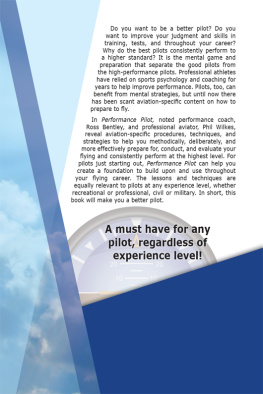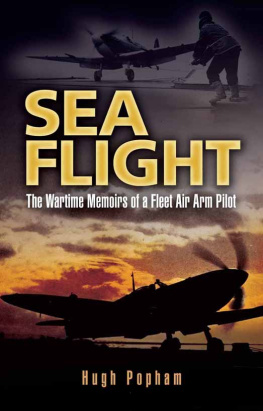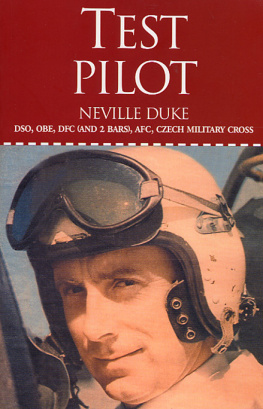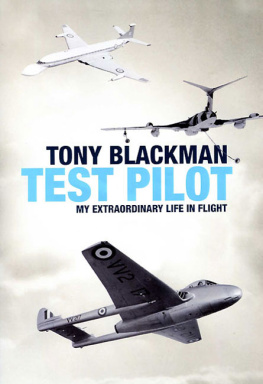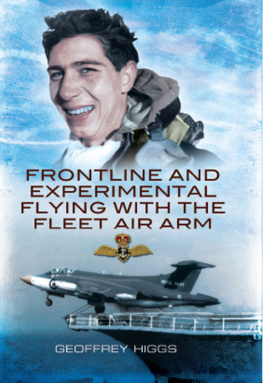
To my wife, Ann, for your help and necessary constant encouragement.
To the Royal Navy, for my education.
And to the memory of many friends lost along the way.
Contents
Foreword by
Sir John Treacher KCB
I am pleased that David has decided to record his brilliant flying career, which was well and truly launched when his first squadron embarked in the aircraft carrier HMS Victorious in which I was serving at the time.
His natural ability was quickly recognised and he was soon selected for advanced training as an air warfare instructor and then for the Empire Test Pilots School.
It was not long before British Aerospace realised his potential and the navy was happy to have him become chief test pilot of future developments.
Admiral Sir John Treacher KCB
Commander (Air) in David Eagles first embarked squadron in HMS Victorious ; Captain of the aircraft carrier HMS Eagle ; retired as Commander-in-Chief, Fleet
1
My flying career started in the library of Mirfield Grammar School, in the West Riding of Yorkshire, in the middle of 1953. I was studying Geology at A level but had become aware that I would have to join one of the services for national service, either before or after university. I began to consider which of the three services it should be and I came across two paperback books in that library. They were Fleet Air Arm and Ark Royal , published by the Ministry of Information in 1942 and 1943, and they were full of pictures of pilots in sheepskin-lined jackets leaning into the wind as they made their way up a heaving flight deck to man their fighters. I still have these books and they still give me the same feelings I had then: Where do I join?

HMS Indefatigable in Portland Harbour during 1954.
After much letter writing, form filling and interviewing I arrived at the Naval Air Station at Lee-on-Solent and began the uncomfortable experience of becoming a naval airman 2nd class and a national service upper yardman. There were twenty of us in that intake and after a week of kitting out and square-bashing we joined the Fleet Carrier HMS Indefatigable in Plymouth.
Indefat , still bearing the scars of a kamikaze attack from her time in the Pacific nine or ten years earlier, was now a floating classroom for training all manner of entries into the Royal Navy, including the national service entry of would-be Fleet Air Arm fighter pilots.
For the next six months we sweated through courses on seamanship, anti-submarine warfare, communications, navigation, parade training and how to be a naval officer. Much of our time was spent tied up to a buoy in Portland Harbour and it was there that I was to get airborne for the first time in uniform, when we were given a single air experience flight in an RAF Sunderland. The grand old aircraft landed inside the harbour and took us on a run along the south coast at low level, circling over Calshot to let us see the three Princess flying boats on the bank there, two cocooned and one apparently in flying order.

En route to Pensacola in June 1954. Left to right, back row: Miller, Bradbury, Caine, Smith, Harvey, Hopkins, Hawes; front row: Ogilvy, Phillips, the author.
Indefat also gave us some sea time and was involved in exercises in the Atlantic and the Mediterranean, so as well as bouts of seasickness we felt as if we were getting closer to the action. During this time their lordships at the Admiralty realised they werent going to get their moneys worth out of us in the two years they had us in their power. Therefore they changed the rules and announced that if we wanted to continue with our dream of becoming Fleet Air Arm pilots we must sign on for a four-year short service commission. All twenty of us signed. I had left the comparative comfort of West House, Mirfield, where I lived with my father, Richard, a tool-maker with a Brighouse engineering firm; my mother, Nellie, the daughter of the Rastrick barber; and two sisters, Jean and Josephine.
These were the days of the Cold War and Britain was broke after her efforts in the Second World War. The Americans offered several European countries, including Britain, the Mutual Defense Assistance Program (MDAP), to boost NATO capability against the growing Soviet threat. This programme assisted with rearming and with military training. And so it was that when, in June 1954, we graduated from our upper yardman training programme as fully fledged midshipmen, ten of us were fortunate enough to be sent to do our flying training with the US Navy, starting in Pensacola, Florida. As luck would have it, the only ship that could get us to the States in time for the start of our course was an all-first-class affair, the Cunarder RMS Media .
On the Media we met six more Royal Navy officers who were travelling to the same course and who were all lieutenants who had graduated through the Naval College at Dartmouth. In the US Naval Air Station at Pensacola, the lieutenants were accommodated in the bachelor officers quarters in comparative luxury, while we short service midshipmen messed with the American Naval Aviation cadets.
The Naval Air Station at Pensacola was, and still is, a massive organisation. It has its own deep-water harbour where carriers can get alongside, a large airfield, extensive living accommodation and university-standard lecture theatres. Within 30 miles there were several other outlying airfields and the American training system moved the students from one field to another for the various phases of basic training. We did our preflight training at Mainside, Pensacola, training to solo at Whiting Field, formation flying at Saufley Field, bombing, gun firing and deck landing from Barin, and instrument flying and night flying at Corry. The aircraft used at all these bases was the North American SNJ, or Harvard as it is known in the UK. And the size of the operation was huge. At Whiting Field alone there were more Harvards on the line than we had aircraft in the whole of the Fleet Air Arm. Where the UK was sending, on average, fifteen students into this programme every six months, the Americans were injecting thirty a week!
The preflight training at Mainside was riveting for that first four weeks before flying. The organisation picked you up into a fast-moving, highly disciplined, and very professionally run training machine. As part of the familiarisation with the SNJ our twenty-strong group was taken to an engine-running familiarisation pen. Here, in a Dutch barn arrangement, were about ten Pratt & Whitney R-1340 radial engines, which powered the trainer we were shortly to use, each mounted on a steel frame and operated from a small control panel behind a protective glass window. On this rig we were to demonstrate that we understood the start-up procedure and the means of control through the throttle and the propeller pitch lever. We stood in line waiting to be called to a vacant rig, watching impressive fires being produced by over-priming, and the whole scene produced an ear-ringing din.
The American training system was quite different from that in RAF Training Command, where those from our course who stayed back in the UK were trained. With the US Navy, each phase of training consisted of a set number of flights, each of which was pre-planned to the nth degree and with a printed form for each sortie (see opposite).
Next page


